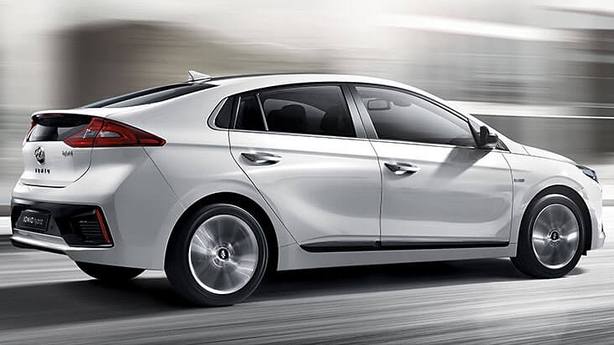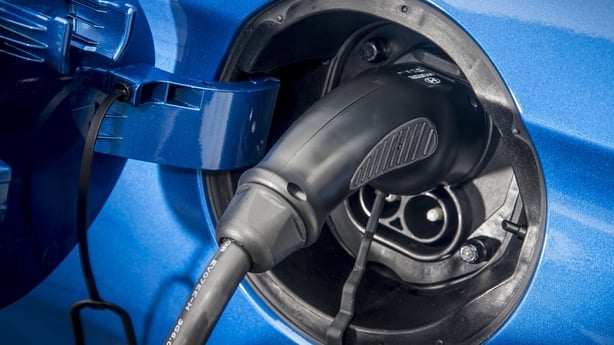Until now the Nissan Leaf was the only all-electric volume car on the market. Now the Koreans have arrived with another one. Donal Byrne has been driving the newest electric car on the block and gives you the low down on what's involved in all-electric driving.
If anecdotal evidence is anything to go by, we are now far more interested in exploring electric cars and hybrids than we were this time last year.
A few car sales people I’ve spoken to recently say that thanks to the foreseeable demise of diesel, people are beginning to ask what kind of car they should buy next and how it will be powered? There is no easy answer and the options are confusing.
The Hyndai Ioniq is a case in point. It comes as a hybrid (a car with a petrol engine and an electric motor that charges itself), a plug-in hybrid (a car whose electric battery you charge yourself and is complemented by a petrol engine) and as an all-electric car that runs on charges alone and has no petrol engine. Which to choose then?
The only way to find out is to do some initial research based on your driving style and mileage. If you regularly drive from Dublin to Cork, for example, and you are not willing to allow for charging time en route then an all-electric car is pointless.
If, on the other hand, you drive from the Dublin suburbs to work or other comparable short distances, the all-electric may make a lot of sense.
As long as you are not the kind of person who decides on a whim they would like to get to Cork and back in a big hurry without charging, that is.
If, on the other hand, you would like to mix battery power with the engine to get the best flexibility then the hybrid might be the best option.

The range claimed for the Ioniq is 270km but real-life conditions limit that.
Hyundai says the electric car is capable of running 270km on a single charge. That might happen in a perfect test environment but not in real life.
About 200kms might be possible under ideal driving conditions but in Winter, for example, there is more to drain the battery (heater, demister and so on) and 140kms would be nearer the mark.
And your driving style will also greatly affect the range. Without any aggressive driving on my part, I found the range reducing more quickly than I thought.
However, when I applied myself to more sedate driving, the available range remained more constant. So, unless you are prepared to adapt a sedate driving pattern and are happy to match your speed to your consumption then electric will not be for you.
The Ioniq electric is really designed for slow to moderate city driving, when it comes into its own.

There are no charging fees at the moment but fees will eventually be introduced.
Those living in apartments or without off-street parking and access to a home-charger are pretty much ruled out when it comes to electric cars.
A domestic charge for the Ioniq will take a few hours at least and less at a fast charging point, but you still need to calculate your driving carefully. Also, bear in mind that you will have to get used to using a cable to charge the car and you must have access to a charging point that is a practical proposition.
With all this in mind, I have a piece of advice for anyone contemplating buying an electric car: Insist to your dealer that you get more than a brief test drive.
I would insist on having the car for at least three days or even more to allow yourself get a feel for the car and how it might or might not suit your circumstances. Electric cars are not cheap to buy and deserve a great deal of thinking about before committing.
So, to the Ioniq electric. It is a car for people who care more about the environment than the styling of their car. It is blandly designed and where the front grille should be (no need for a grille because there is no engine) is a plastic mould that looks like an unpainted panel.
All the emphasis here has been on weight and keeping it down, so the result is an efficient shape but not one that arouses any passion. This really is an exercise in wrapping an aerodynamic shape around a sub-frame and electric power source.
This explains the rather functional shape of the car compared to other Hyundai models, which are very impressive in the main.
As with all electric cars, the Ioniq drives silently and has very good acceleration - it's even better with the sports mode used but this will eat into your battery charge.
Sedate driving really does get the best results and the battery will re-generate under braking, although the braking does take a little time to get used to. The car runs without the stress of gear changing - there are no gears - and is ideal for city driving.
The Ioniq will take four people in comfort but the slope in the roof at the rear restricts comfort in the back and the rear visibility is badly impaired because of a bar-like spoiler addition across the rear window.
The boot is also a bit limited because of battery size but it will still accommodate a modest load.
The interior of all three Ioniq options, including the hybrid version, get a bit of a lift with the use of different coloured plastics and the driving environment is pleasant. There is also a good display screen, easy controls and an easy to live with finish.
The Ioniq comes in at €28,495, which includes the €5,000 grant you get for electric. So, it's not cheap, but then you don't have to pay for fuel, parts or the other running costs you have with conventional cars.
Standard equipment includes the seven-inch screen, alloy wheels, stop and start system, rear camera and sensors, a lane departure warning and Bi-Xenon headlights. Map Car and Tom Tom Live are also featured.
Going electric is not without its issues and these need to be looked at very carefully. However, the Ioniq is a very impressive arrival that appeals to early adapters rather than traditional drivers - unless they are willing to change some driving habits.
I suspect many people anxious to look at alternative power sources may look to the hybrid version first as it is more familiar and does not involve the limitations of cables and charging.
But if electric does suit your needs then it is certainly one to look at - its benefits are in the longer term. Just make sure it suits your driving requirements and range anxiety is not an issue for you.


